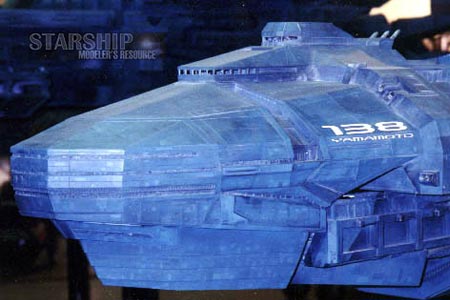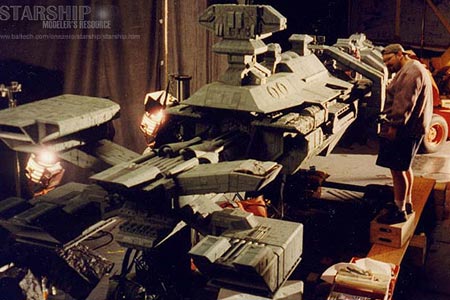Interview: George Willis on making the Rodger Young for Starship Troopers
The man who brought death and destruction to the wonderful ship in Paul Verhoeven's cult favourite tells us how he did it...
Master model-maker and movie fabricator George Willis has just finished outfitting Mickey Rourke for Iron Man 2. He’s as busy and in-demand as ever, but less so for spaceships in these days of CGI (sigh). In support of Top 75 spaceships in movies and TV, we had a chat with George about his time working on Paul Voeherven’s Starship Troopers…
What can you tell us about working on the Rodger Young?
When we first got the designs for it, everyone was sort of sceptical and a few were rolling their eyes because the basic shape of it was reminiscent of the Battlestar Galactica. But as we worked on it, putting all these details on to it, it was just so much fun. We really came to love it. There are a lot of archetypal things that show up in spaceships – having the engines out on these kind of pods sticking out, and this lumbering sort of frame and all this great panel detail.

I think one of the things I like about the ship is that it has a kind of ‘whale’ look to it…
Yeah – it really has the look of a battleship. It’s very heavy and lumbering. I worked on a TV show about 15 years ago that ran for six episodes called Space Rangers. It was kind of a bad Battlestar Galactica/Star Trek rip-off. But the main ship had a really weird shape, where the designers just decided ‘Let’s make it different from all the other spaceships that have ever been done’. So it sort of looked like a Concorde jet – it was very long and sleek, but it had a lop-sided wing; there was an engine on one side and no engine on the other side and it just looked like it wouldn’t fly and it would never go in space. There were a lot of things wrong with the show, but not that – when you looked at it, you didn’t think ‘spaceship’.
When you look at the Rodger Young you think that it’s this big, heavy indestructible battle-cruiser. It hangs there…
It’s got the NASA thing as well – the kit-bashed detailing that Kubrick and Trumbull pretty much originated…
Yeah, once that’s on, that’s just what spaceships are supposed to look like. Even the real ones look nothing like that [laughs].
How many versions were there of the ship?
There were three main versions. There was one that was eighteen feet long, and then there were two that were nine feet long. The eighteen-foot version was actually built where it would come apart in two sections for the destruction sequence. I wish I had it in a digital format that I could send you, but there’s a designer’s rendition of how the damage would spread once the nuclear bug-juice hit the Rodger Young and started eating it away.
A great deal of model-making effort seemed to have gone into that section of the movie where the ship is split apart…
It’s interesting, because when that project was done we were really on the cusp of when computer animation and effects were really coming into their own. At the time there was this big surge, maybe around 96-97, when all of these big-budget action films came out at the same time. There was pretty much one coming out every weekend that summer. You had Batman 4, Alien 4, Armageddon. Independence Day and Twister had come out a couple of years earlier, and this surge was coming out towards the end of this Stallone/Schwarzenegger/Willis era, and when Twister and Independence Day came out, they both made a huge amount of money and they weren’t that big a budget films. They were sort of medium-budget action films and they didn’t really have any stars. Will Smith wasn’t really a huge star yet, and the biggest star in Independence Day was Bill Pullman.
But these films made a ton of money in the box-office, so the studios suddenly went ‘Oh, we don’t need to be spending twenty-five million dollars on a star, we’ll just spend twenty-five million dollars on the special effects, and that will make the film successful’. There were then probably a dozen films made within a year of each other that cost over a hundred million dollars each.
Armageddon, they say was a success, but for how much it cost, it was still kind of a disappointment. The only real runaway hit in that time was Titanic.
But anyway, at the time they were making all these big-budget action films, and there weren’t enough computers in the world to do the animation. There were computers that hadn’t been made yet that had been bought in advance to be working on these films. So part way through the project as we were building the spaceships for Starship Troopers, Sony at the time had its own model shop, which was called Thunderstone. They were doing Starship Troopers and Contact at the same time.
What happened was that the Starship Troopers art department came to the model shop with a bunch of storyboards and said ‘Which of these shots could you do in some way other than computer effects?’. They were budgeted out. Just the rendering time that was required to do these shots was a huge obstacle. With the amount of computers they had and the ones they were able to get, there was no way they were going to be able to finish Starship Troopers in time for the release date.
So the model shop took a look and said ‘We can do this bit with stop-motion animation’. Basically in the cavity that’s blown open by the nuclear bug-juice, they had a close-up shot of about eighteen or twenty interior floors.

I was watching the film this week, and that shot still makes a big impression.
Well, that’s one that I worked on. I designed a rig that had about eighteen or twenty bass-guitar tuning pegs, from the neck of a guitar; you twist them and they have that little worm-drive on them. I made all these rods that were basically brass tubes running behind it, and had all the cables running through the floors to the outside edge, where the floors were actually composed of two sheets of aluminum foil. They were sandwiched together with a bunch of photo-etched brass to get the structure. With each twist of these guitar-tuning pegs, the floors would collapse a quarter of an inch or so.
They put the two halves of the Rodger Young in one piece upon this giant motion-control camera rig called a model-mover, and it slowly moved the sections apart, an eighth of an inch per frame. It was only a five-second sequence, but it took about two hours to shoot. They’d say ‘action’ and take a shot of one frame, and we’d go and twist these guitar tuning pegs and make the floors collapse, and there were a few little beams that crashed and towers that fell over and other things.
Was this something that couldn’t have been conceived with motors?
The problem with motors is that all of the tiny details with the floors crushing would have been too difficult to do with motors, and it would have been hard to do it that slowly. Basically it’s just five seconds that these floors tear apart and crush. It took about two days after each shot to sort out all those interior floors. In the end they added a lot of computer-generated fire effects and stuff like that over the floors, to the point where you really couldn’t see that much of the effect. There was this guy called Pete Kleinow, who was the lead animator on it, and I was working with him. He was a legend in the stop-motion world; he actually worked on a pretty famous American television show in the sixties and early seventies called Gumbie. I don’t know if they had that in the UK…?
If they did, it passed me by!
It was a little green…he looks like a stick of gum, basically. But it was fun learning from Pete, and the different ways of animating something so that it moves in a more fluid way.
Who actually designed the Rodger Young?
All I did was actually design that animation rig that was inside of it. But another funny story is that in addition to the eighteen foot and the two nine foot versions, we made twelve of them that were nineteen inches long and perfect replicas of the big one. These were used for the mass fleet-attack. They had all of them in play at once, whereas [laughs] they could have just duplicated one. But the way they did it at the time, they didn’t want to mess with tying up the computers, so they just made twelve of these little ones.
The big ones were nice, and those ended up in some Sony museum somewhere, I’m sure. But the little ones…all the model-makers were salivating over these things [laughs]. Every model-maker collects things from movies they’ve worked on, and these were a perfect size for you to display on your mantle. They kept asking the shop foreman ‘Hey, what’s going to happen to these twelve little ones when the movie’s over?’. There were nearly fifty people working in the shop at the time, and they were all asking about these.
The shop foreman said no, there’s not a chance. These were already spoken for; the producers were each going to get one, and a couple of people at Sony and different departments too. So they said ‘No, you’re not going to get one’.
Anyway towards the end of the project, the guys who were making the little ones kept putting in more orders, and the boss came in and said ‘Oh, we’re going to need a couple more of these for the agents’, and the stars wanted one. At the point where they were making about ten more than they were going to be filming, they had just started making them as souvenirs for some of the bigwigs working on the film.
Finally the boss came in and said ‘Okay!’ [laughs] ‘Everyone that wants one can have one of these, but you have to cast up the parts and you have to assemble it on your own time. But everyone gets one!’. So I’ve got one sitting right here in my kitchen.
So that was one of the big pay-offs of that film for us. We were all so excited when we watched the dailies, because the shots were just beautiful. The ships were coming out of the docking bays and stopping and falling through the atmosphere. We all believed that it was going to be the next Star Wars, [laughs] and we were all so disappointed when the film wasn’t as successful as we would have liked.
Did Paul Verhoeven have much input into these model shots?
I’m trying to think – I don’t really recall him being around the shop. I’ve worked on other films with him. I actually worked on Total Recall with him.
I noticed! Were you working on the one spaceship in that film – the Mars ferry?
No, I worked on the landing bay area. The guy that built that ship was Ian Hunter, who now runs Hunter-Gratzner. He was basically a model-maker back then.
I was talking to him about two hours ago regarding Pitch Black.
Yeah, he built that one almost single-handedly. The model’s only about two and a half foot wide. It is quite a small, incestuous community here in Hollywood, and we all seem to have worked on a lot of the same things.
Is trade still brisk in the CGI age?
It’s interesting – there really is now only one model-shop that I know of, which is Hunter-Gratzner, which still does a lot of motion picture models. That’s because they’re a sort of self-contained studio where they have shooting stages and a lot of cameras, and they have a CG department and everything. But they generally only use miniatures like that on high-budget films for the big destruction sequences. The last model I worked on for a feature was X-Men 3, and that was the Golden Gate bridge that gets destroyed. That’s because if it’s a $100 million movie, the director is a big enough personality that they can fight with the producers and say ‘Look, this shot is important – it’s got to look real and the only way that we can do it is with a miniature’…and squeeze a half-million dollars out of the budget to build it.
The model in X-Men 3 was thirty feet high and fifty feet long…but other than that, most of the features that I’ve worked on in the last couple of years have been doing costume props and industrial stuff. I made some of the robots for I Robot. And then last year I worked on Race To Witch Mountain; more for kids, but there was a Predator-type alien in it that had guns and weapons and things that popped out of the wrist of his suit, and I built all those.
So the model-making skills have transferred over nicely into building these armoured suits. Actually I finished about two weeks ago on Iron Man 2, where we were building all the armour suits. All the scenes where Iron Man is flying around, that’s done with CG and it looks great, but the close-ups where he’s got the helmet off and he’s talking to people, or they’ve got the suit just lying there in the shop and they’re working on it – they have to have a physical prop for it.
So there’s been a bit of a Renaissance, I think because of all these comic-book movies like X-Men and Iron Man, and films like that where there’s a lot of money being made. So I’ve transitioned to making the full-size, industrial looking props rather than the miniatures. I also worked on a few commercials for Stan Winston back when it was still Stan Winston’s. Since Stan died some of the producers basically started their own company and out of respect for him called it Legacy instead of Stan Winston.
There are still miniatures being used in Hollywood but it seems most of them are being used for commercials where they need to do something in as little as a couple of weeks. In these cases it’s just a few seconds of a shot, and they’ll make miniature buildings, or whatever’s needed.
Are you against CGI taking over miniature work completely?
They’ve got the CGI down pretty nicely now, where it looks pretty real. I actually had an editorial that I wrote in Wired magazine right around the time I was working on Starship Troopers, basically saying that they still haven’t got the technology down and that CG was great for compositing things and making explosions and water and smoke…like those World War II movies where they’d have a miniature battleship and they’d film it in slow motion with giant drops of water, and firecrackers blowing up…
CGI is surely the best thing for water. Doesn’t seem to scale at anything but 1:1.
Yes, CGI works great for that. But they’ve got it down very well generally, especially for television. I used to do a lot of work with spaceship models and ship models for television. They really don’t use any models for TV anymore because on a small screen with a lower resolution, they can get away with something that looks more like a video game.
So personally I’m against it – I’m sad to see that they’re not using nearly as many models as they used to. But then there have been some bad models over the years too, in movies. Some movies have bad models and some have bad CG. Logan’s Run I loved as a kid, but it has some pretty problematic models in it…
George Willis, thank you very much!

